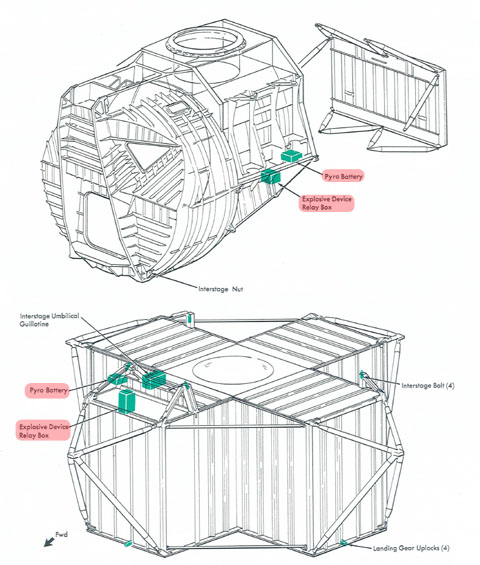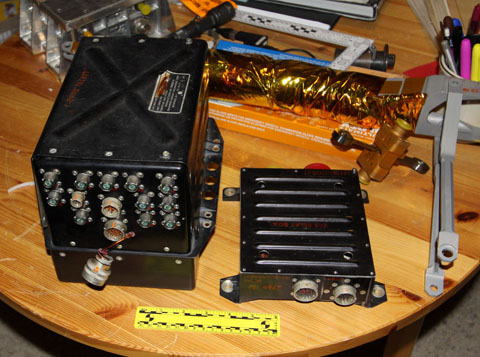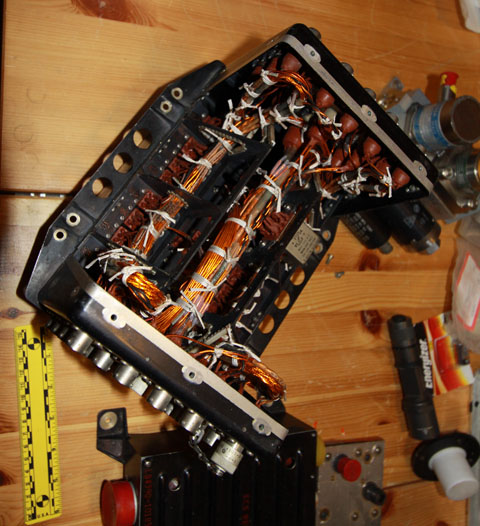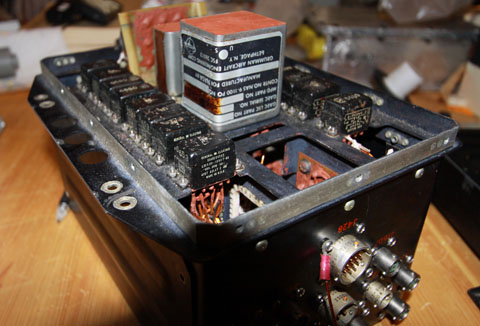|
Author
|
Topic: Apollo lunar module: Ascent engine failure
|
Fra Mauro
Member Posts: 1624
From: Bethpage, N.Y.
Registered: Jul 2002
|
 posted 04-28-2011 10:18 AM
posted 04-28-2011 10:18 AM
   
Approximately how long would the consumables last if the Apollo lunar module's ascent engine failed to ignite? Since the umbilicals to the descent stage were cut before a launch, I would think less than a day. |
SpaceAholic
Member Posts: 4494
From: Sierra Vista, Arizona
Registered: Nov 1999
|
 posted 04-28-2011 03:37 PM
posted 04-28-2011 03:37 PM
   
The answer is challenging without remodeling consumption on a static vehicle and crew (the power, oxygen, and cooling budget was predicated on a flying ascent stage with electronics, electromechanical devices energized sucking up power and producing waste heat that needed to be rejected into space); and crew metabolic rates associated with work. Additionally, a substantial percentage of oxygen uploaded to the ascent stage was unusable and would have to be accounted for in the revised endurance calculations. |
Lou Chinal
Member Posts: 1332
From: Staten Island, NY
Registered: Jun 2007
|
 posted 04-29-2011 12:38 PM
posted 04-29-2011 12:38 PM
   
As for the oxygen, about 24 hours. I can't quote anything off hand but in all my reading about LM system's I'm going to say about 24 hours past a maximum of three days stay time (for a 'J' mission) on the lunar surface.I think the coolant water for the electrical system might not hold up even that long. |
SpaceAholic
Member Posts: 4494
From: Sierra Vista, Arizona
Registered: Nov 1999
|
 posted 04-29-2011 07:34 PM
posted 04-29-2011 07:34 PM
   
Here's a rough swag: - 4.8 pounds uploaded at launch to both ascent stage 02 tanks (2.4 pounds each tank, about the same for all missions)
- 17 percent (or .8 pounds) unusable/unavailable due to leakage, trapped gases, gauging error - yields 4 pounds total available.
Mean consumption rate for a 150 pound astronaut comfortably at rest (essentially motionless) .05 pounds O2 per hour equates to 40 hours per astronaut available oxygen. This does not include residual oxygen remaining in the cabin from the descent stage O2 tanks at separation. |
golddog
Member Posts: 210
From: australia
Registered: Feb 2008
|
 posted 04-29-2011 08:55 PM
posted 04-29-2011 08:55 PM
  
When asked that question prior to Apollo 11, I believe Neil Armstrong answered that whilst he did not have the exact figures, he believed it would be a matter of a couple of days. |
Max Q
Member Posts: 399
From: Whyalla South Australia
Registered: Mar 2007
|
 posted 04-30-2011 08:29 AM
posted 04-30-2011 08:29 AM
   
I am left wondering what sort of repair options, tools available and training the lunar surface crew might have had to repair the ascent engine? However unlikely, would basic repairs within the LM have been possible and how about external, did they have any knowledge of basic repairs (not that they would have been that basic)? |
ringo67
Member Posts: 181
From: Seekonk, Mass., USA
Registered: May 2003
|
 posted 04-30-2011 11:42 AM
posted 04-30-2011 11:42 AM
   
I'm no engineer, but I've got to think very little training was done on repairing the ascent engine. Even with the protection of a space suit, you wouldn't want to be messing with a fully-fueled hypergolic engine system, especially in a craft as fragile as the LM.Of course the simplicity of the system was meant to avoid such problems, open two valves, fuel and oxidizer mix and liftoff. That's my view, and let me say it again, I'm not an engineer. |
SpaceAholic
Member Posts: 4494
From: Sierra Vista, Arizona
Registered: Nov 1999
|
 posted 04-30-2011 01:30 PM
posted 04-30-2011 01:30 PM
   
There were several subsystems and components which in theory could have prevented stage separation, ignition and liftoff beyond the ascent engine. Almost all these had backup. The engine itself was bullet proof. The most susceptible area of failures would have been the Valve Package Assembly (VPA) and Injector — both went through protracted engineering and redesign to make sure they would not fail under any conceivable circumstance. An example of the VPA and its fully redundant design are detailed on this page of my site. What else external to the engine could go wrong? Propellant system pressurization failure (i.e. tank ruptures and helium is lost to space; feed line blockage; stuck valve), propellant contamination, malfunctioning explosive device battery, inop relays, squibs, shorted (or an open) switch, severed wiring harness, a loose connector. An example of a potential failure point - the Explosive Device Subsystem. It had a role throughout the LM's mission; for lunar departure, functions included propellant pressurization, severing inter-stage structural connections, and electrical circuit interruption. The Explosive Device Relay Box was the central point for initiation of each of these actions (via Astronaut toggled command from the EDS control panel). There were two relay boxes (one each in the Ascent and Descent stage). The relay's when closed provided the necessary voltage to trigger detonation of the explosively actuated interrupters and guillotines. An example of the Explosive Device Relay Box is shown below with its two respective locations on the flight vehicle. Assuming both boxes failed, and the astronaut had the correct tools to access the box, bypassing a faulty relay would be very challenging.  


|
moorouge
Member Posts: 2458
From: U.K.
Registered: Jul 2009
|
 posted 05-01-2011 02:19 AM
posted 05-01-2011 02:19 AM
   
The technical details are interesting, but so far nobody seems keen to address the human aspect of a failed ascent stage. Though the mechanics of Apollo are important, the whole point of the project was that it was manned.Were there contingency plans for the crew in the event of such a failure, or would NASA have made it up 'on the hoof'? Would the crew have continued to explore until supplies ran out? Would they, at some point, decide to end it? How would NASA have reacted, for example, would transmissions from the Moon been ended to leave the crew in peace? Or are these questions that will forever remain unanswered with the thanks of all concerned that they never had to be faced? |
golddog
Member Posts: 210
From: australia
Registered: Feb 2008
|
 posted 05-01-2011 03:33 AM
posted 05-01-2011 03:33 AM
  
In the case of Apollo 11, then President Nixon had a prepared speech (written by William Safire) and instructions to ring the widows to be before reading it, whilst it was planned to have a priest read out a ceremony similar in style to that of a burial at sea. I believe NASA intended to cut the public loop to the transmissions from the spacecraft to allow the men some privacy, whilst Collins would have returned to Earth in the CSM. |
Max Q
Member Posts: 399
From: Whyalla South Australia
Registered: Mar 2007
|
 posted 05-01-2011 04:08 AM
posted 05-01-2011 04:08 AM
   
How long would the CSM have remained in lunar orbit? One would think at least till those on the surface where dead. And the lunar crew, do you think they would have remained in the LM or opted to spend their last moments on the surface?I found it very hard to type this but I do wonder. |
golddog
Member Posts: 210
From: australia
Registered: Feb 2008
|
 posted 05-01-2011 04:40 AM
posted 05-01-2011 04:40 AM
  
I doubt the CSM would have remained in orbit for any length of time if it was beyond hope for the LM to launch. As for the LM crew, they would not have had the option of leaving the cabin. |
Max Q
Member Posts: 399
From: Whyalla South Australia
Registered: Mar 2007
|
 posted 05-01-2011 04:52 AM
posted 05-01-2011 04:52 AM
   
Of course the LM crew would have jettisoned everything required to leave the LM. But the CSM would have been a different matter. I have my doubts that they would have left orbit until after the passing of the surface crew. I think NASA might have wanted them to but convincing them to leave might have been hard. |
moorouge
Member Posts: 2458
From: U.K.
Registered: Jul 2009
|
 posted 05-01-2011 07:08 AM
posted 05-01-2011 07:08 AM
   
quote:
Originally posted by golddog:
As for the LM crew, they would not have had the option of leaving the cabin.
Why not? I can think of no reason why, in these circumstances, they shouldn't leave the cabin if that was what they wished to do. |
ilbasso
Member Posts: 1522
From: Greensboro, NC USA
Registered: Feb 2006
|
 posted 05-01-2011 07:14 AM
posted 05-01-2011 07:14 AM
   
They had already tossed their PLSS's (backpacks) out the door in preparation for ascent, to save weight. They could not have disconnected from the LM cabin air supply at this point in the mission. They could not have gone outside to effect repairs.When the time for the end came, they did not carry "black pills" (cyanide), as the press had speculated. All they had to do was depressurize the cabin, and they would have been unconscious within seconds. |
moorouge
Member Posts: 2458
From: U.K.
Registered: Jul 2009
|
 posted 05-01-2011 08:40 AM
posted 05-01-2011 08:40 AM
   
My point was that if a crew chose to meet the end on the surface they could rely on just the oxygen in the suit. In this case they wouldn't need the PLSS units, just be able to seal the connect to the cabin oxygen supply. |
ilbasso
Member Posts: 1522
From: Greensboro, NC USA
Registered: Feb 2006
|
 posted 05-01-2011 09:53 AM
posted 05-01-2011 09:53 AM
   
I wonder how long the air in the suit alone would last? Probably not even long enough to wriggle out of the hatch. |
Obviousman
Member Posts: 438
From: NSW, Australia
Registered: May 2005
|
 posted 05-02-2011 08:42 AM
posted 05-02-2011 08:42 AM
   
One has to wonder, though, about what people might have done in such circumstances. If faced with certain death, some astronauts may have considered risky - even desperate - actions because they would have nothing to lose. For instance, how long could an astronaut last in the PGA without a PLSS? Could they have gotten out to collect a discarded PLSS (without the PLSS they would have been able to get out the hatch much more easily)... even if it possibly meant that that person would almost certainly die but give their partner the opportunity to try to "repair" the "fault" externally? |
sts205cdr
Member Posts: 649
From: Sacramento, CA
Registered: Jun 2001
|
 posted 05-02-2011 11:50 AM
posted 05-02-2011 11:50 AM
   
They would still have their OPS units after discarding their PLSS packs. This was in case they couldn't re-dock with the CSM and needed to do a crew transfer EVA. For what it's worth... |
sts205cdr
Member Posts: 649
From: Sacramento, CA
Registered: Jun 2001
|
 posted 05-02-2011 12:30 PM
posted 05-02-2011 12:30 PM
   
In the case of a ascent stage battery failure, for example, they could have used the OPS to go outside and access the descent stage battery to connect a jumper cable they had onboard. |
SpaceAholic
Member Posts: 4494
From: Sierra Vista, Arizona
Registered: Nov 1999
|
 posted 05-02-2011 04:24 PM
posted 05-02-2011 04:24 PM
   
The descent stage ED battery was wired into both relay boxes to provide redundancy. |
Obviousman
Member Posts: 438
From: NSW, Australia
Registered: May 2005
|
 posted 05-03-2011 12:52 AM
posted 05-03-2011 12:52 AM
   
I forgot about the OPS. The could have retrieved the discarded PLSS, if they thought they would be useful. |
golddog
Member Posts: 210
From: australia
Registered: Feb 2008
|
 posted 05-03-2011 03:04 AM
posted 05-03-2011 03:04 AM
  
How many separate batteries were there? |
SpaceAholic
Member Posts: 4494
From: Sierra Vista, Arizona
Registered: Nov 1999
|
 posted 05-03-2011 07:28 AM
posted 05-03-2011 07:28 AM
   
For the independently energized Electro-Explosive Device (ED) subsystem, there were one each .75 amp hour battery in the Ascent and the Descent stage. LM primary electrical power was supported by two 296 amp hour batteries in the Ascent stage and four 400 amp hour batteries in the Descent stage; a 5th was added for the extended stay J-Mission LM's (this same Descent battery was also adapted as a retrofit to the service module for back-up power as a result of lessons learned during the Apollo 13 accident).
|
KA9Q
New Member Posts: 3
From: San Diego, CA
Registered: Mar 2012
|
 posted 03-29-2012 01:24 PM
posted 03-29-2012 01:24 PM
   
It is certainly highly questionable whether the astronauts could repair any credible malfunction of the ascent propulsion system before their ascent consumables ran out. The ascent stage had limited battery power: 600 amp-hours vs 2,000 in the descent stage, and some of that 600 Ah had been used during descent when all LM batteries were tied together in case they were needed in a sudden staged abort.There is also correspondingly less O2, H2O and LiOH in the ascent stage, just enough for the ascent and rendezvous. In fact, many of the CSM's contingency rendezvous plans for reaching a disabled LM that had somehow reached orbit were seriously constrained by the LM's endurance. Once the LM staged, it really had to find the CSM in just a few hours. In the event of a failed liftoff that severed the interstage supply connections, the astronauts could have used their OPS to supplement the ascent O2 supply. The OPS actually contained considerably more O2 than the PLSS and they could probably reclaim any unused LiOH cannisters stored in the MESA. That leaves water and power as the critical items, just as they were in Apollo 13; it would be difficult to reconnect those supply lines to the descent stage. But I see a much bigger problem in all this. I understand that everything happens at once during ascent; the guillotine cable and pipe cutters are fired, the bolt cutters are fired to sever the interstage bolts, and the ascent engine is started. If everything works except the ascent engine, what happens? I can't rule out the ascent stage promptly sliding off the descent stage and ending up face-down in the dust, irreparably damaged. If that didn't happen immediately, it would probably happen when the astronauts tried to move around to do their emergency repair EVA. |
MadSci
Member Posts: 230
From: Maryland, USA
Registered: Oct 2008
|
 posted 04-07-2012 02:11 PM
posted 04-07-2012 02:11 PM
  
Well we have a partial answer to what they would do in the case of an equipment failure that would prevent the Ascent stage liftoff. Aldrin fixed the broken ascent stage arming circuit breaker with a felt pen. According to Ton Kelly he did so ignoring the instructions sent up to the LN to engage the backup circuit breaker.I'd say they would have taken a hands-on approach to solving whatever problems they faced. |
wickball
Member Posts: 107
From: Cleveland, Ohio, USA
Registered: Jul 2005
|
 posted 04-07-2012 02:50 PM
posted 04-07-2012 02:50 PM
   
quote:
Originally posted by KA9Q:
I can't rule out the ascent stage promptly sliding off the descent stage and ending up face-down in the dust, irreparably damaged.
Do you know if the ascent stage engine bell was flush with the top surface of the descent stage? Perhaps it may have recessed into the descent stage to prevent it from sliding off. |
Rusty B
Member Posts: 239
From: Sacramento, CA
Registered: Oct 2004
|
 posted 04-07-2012 03:37 PM
posted 04-07-2012 03:37 PM
   
They did toss out the PLSS back packs, but I believe they kept the emergency oxygen packs (OPS) for a contingency spacewalk to reach the CM if the LM was unable to dock or if the CM/LM tunnel was blocked or wouldn't open.On the last three Apollo moon missions, I believe the command module pilots used the OPS packs, returned from the lunar surface, during the spacewalk to retreive the film packs from the service module. |
Blackarrow
Member Posts: 3160
From: Belfast, United Kingdom
Registered: Feb 2002
|
 posted 04-07-2012 05:45 PM
posted 04-07-2012 05:45 PM
  
I actually asked Jim Irwin a question along these lines in 1983, but in the context of a bad landing resulting in the LM ending up tilted at such an extreme angle that the ascent stage could not have launched successfully. (This might have happened on Apollo 16 if the LM had manoeuvred backwards a little and the rear leg had gone into the steep crater which lay just behind the actual landing-site.) I wondered whether the crew would have used the available equipment (geological tools, even the electric drill) to remove regolith or even cut off parts of landing legs to bring the LM back to a safe angle for launch. Colonel Irwin smiled and simply said: "I think we would have been extremely resourceful in those circumstances." Of course, in that scenario the astronauts would have had over 40 man-hours in which to be resourceful. |
Max Q
Member Posts: 399
From: Whyalla South Australia
Registered: Mar 2007
|
 posted 04-09-2012 06:42 AM
posted 04-09-2012 06:42 AM
   
I think these incredible men would have surprised us all with their ingenuity and inventiveness. Lets face it they would have faced a very long walk home. |
Jim Behling
Member Posts: 1488
From: Cape Canaveral, FL
Registered: Mar 2010
|
 posted 04-09-2012 11:11 AM
posted 04-09-2012 11:11 AM
   
quote:
Originally posted by wickball:
Perhaps it may have recessed into the descent stage to prevent it from sliding off.
That would have damaged the nozzle. It was fracture sensitive. |
Fra Mauro
Member Posts: 1624
From: Bethpage, N.Y.
Registered: Jul 2002
|
 posted 04-10-2012 03:18 PM
posted 04-10-2012 03:18 PM
   
Even if it wasn't damaged, a recessed ascent engine might have caused major debris upon ignition. Bottom line — ascent engine failure means an almost certain lunar tombstone. |
Max Q
Member Posts: 399
From: Whyalla South Australia
Registered: Mar 2007
|
 posted 04-10-2012 11:07 PM
posted 04-10-2012 11:07 PM
   
quote:
Originally posted by Blackarrow:
...but in the context of a bad landing resulting in the LM ending up tilted at such an extreme angle that the ascent stage could not have launched successfully.
Interesting point. What was the max angle they could have launched at and how close did they ever get to it? |
golddog
Member Posts: 210
From: australia
Registered: Feb 2008
|
 posted 04-11-2012 10:43 PM
posted 04-11-2012 10:43 PM
  
12 degrees tilt was apparently the limit for a safe lift off. |
SpaceAholic
Member Posts: 4494
From: Sierra Vista, Arizona
Registered: Nov 1999
|
 posted 04-12-2012 02:34 PM
posted 04-12-2012 02:34 PM
   
Falcon experienced an 11 degree tilt; less then 12 degrees was optimal not as a limitation of departure but to reduce the possibility of toppling. |
Jim_Voce
Member Posts: 273
From:
Registered: Jul 2016
|
 posted 12-27-2018 11:54 AM
posted 12-27-2018 11:54 AM
   
I recall that one worry that Neil Armstrong had regarding the lunar module was that its ascent engine had to work — there was no back-up system. If I recall correctly, Armstrong wanted to have some kind of back-up system that would trigger the ascent engine if the primary ignition system failed. There was even a suggestion of igniting it from outside of the spacecraft some how. (On this last point I am probably mistaken. But there was some extreme suggestion of how to get the ascent engine started if it failed to ignite.) In any case, the person Armstrong mentioned this to assured Armstrong that the engine would work and Armstrong had to accept that.Could someone please advise on the correct version of these events and any idea when did Armstrong bring up these concerns? Editor's note: Threads merged. |
Rusty53
Member Posts: 50
From: Rochester, NY USA
Registered: Jun 2010
|
 posted 12-27-2018 01:13 PM
posted 12-27-2018 01:13 PM
  
quote:
Originally posted by Jim_Voce:
Could someone please advise on the correct version of these events and any idea when did Armstrong bring up these concerns?
Armstrong floated the idea of having a manually operated valve as a backup that would allow the hypergolics to flow into the combustion chamber and ignite on contact. No ignition source was needed. |
oly
Member Posts: 971
From: Perth, Western Australia
Registered: Apr 2015
|
 posted 12-28-2018 06:58 PM
posted 12-28-2018 06:58 PM
   
Reading material from Tom Kelly and others involved in the LM and ascent engine designs, the inclusion of some kind of manual valving that would directly control the introduction and mixing of fuels into the combustion chamber of a rocket engine that had experienced serious combustion instabilities for most of its development phase would not be something anyone would want to entertain.At some point, the valve design would have to breach the LM pressure vessel, which would require structural mass increase, requires sealing and become a source of potential leak, in it's simplest form would have at least 1 astronaut not standing during the ignition of a rocket engine, and introduce numerous hardware items that required design, manufacture, testing, and approval. On a vehicle that incorporated chemical milling of parts and Kapton foil insulation to find additional weight savings, installing additional hardware may have pushed the early LM design over the show stopper threshold. |
SpaceAholic
Member Posts: 4494
From: Sierra Vista, Arizona
Registered: Nov 1999
|
 posted 12-28-2018 08:12 PM
posted 12-28-2018 08:12 PM
   
Would have required a major redesign of the engine's valve package assembly in order to divert around the dual redundant/parallel valves on fuel and oxidizer feeds and vent systems. |















